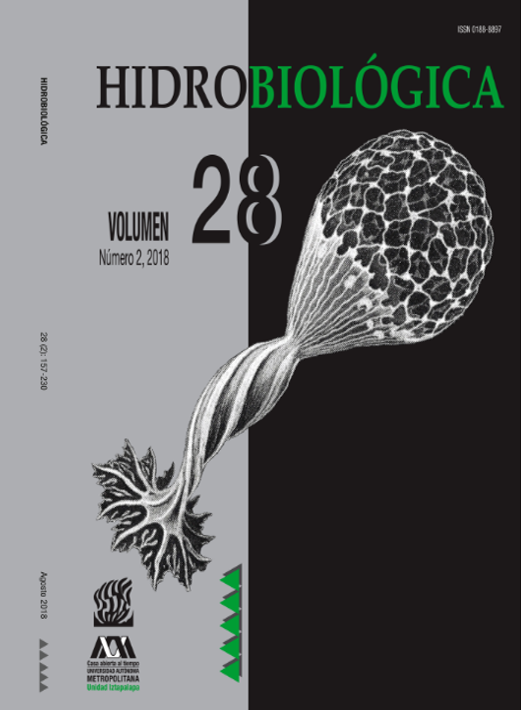Morphological description of adult mouthparts of Urotrygon nana and U. rogersi (Urotrygonidae): Interspecific and intraspecific differences
DOI:
https://doi.org/10.24275/uam/izt/dcbs/hidro/2018v28n2/NavarroKeywords:
batoids, dentition, jaw, morphologyAbstract
Background. Teeth can change significantly in shape and size depending on their position in the jaw, age and sex of the organism. Sometimes due to the loss of these teeth, an incomplete description of the dental morphology exists for several batoid species, which makes it difficult to evaluate intraspecific and interspecific differences. Goals. Describe the differences in tooth morphology as well as the arrangement of teeth in adults of two species of batoids (Urotrygon nana and U. rogersi) distributed over soft bottoms of the continental shelf of the Mexican tropical Pacific. Methods. After collecting the jaws of ten adult individuals of U. nana and U. rogersi we counted the number of rows and series of the first functional row, and described the shape of the cartilage and teeth. In addition, we identified the type of heterodonty. Results. Similarities between the cartilage and teeth of both species were observed. In both sexes of U. nana monognatic heterodonty was observed, with three dental morphotypes in Palatocuadrado and two in Meckels cartilage. U. rogersi has sexual heterodonty with just one morph. Conclusions. We believe it is necessary to expand the number of samples (taking into account the different stages of life), and generate additional ethological studies that provide information on the reproductive behavior of the species.
Downloads
References
Braccini, A. & G. Chiaramonte. 2002. Intraspecific variation in the external morphology of the sand skate. Journal of Fish Biology 61: 959-972. DOI:10.1111/j.1095-8649.2002.tb01855.x
Feduccia, A. & B. Slaughter. 1974. Sexual dimorphism in Skates (Rajidae) and its possible role differential niche utilization. Evolution 28: 164-168. DOI:10.2307/2407249
Gerking, D. S. 1994. Feeding ecology of fish. Academic, California, EEUU. 416 p.
Kajimura, S. & T. Tricas. 1996. Seasonal dynamics of dental sexual dimorphism in the Atlantic stingray Dasyatis sabina. Journal of Experimental Biology 199: 2297-2306.
McEachran, J. D. & M. Stehmann. 1984. A new species of skate, Neoraja carolinensis, from off the southeastern United States (Elasmobranchii: Rajoidei). Proccedings of the Biological Society of Washington 97 (4): 724-735.
Mendoza-Vargas, O. U. & L. Espinosa-Arrubarrena. 2016. Dentición de elasmobranquios, conceptos, patrones, variaciones y terminología. In: Del Moral-Flores L. F., A. J. Ramírez-Villalobos, J. A. Martínez-Pérez, A. F. González-Acosta & J. Franco-López (Eds.). Colecciones Ictiológicas de Latinoamérica. Facultad de Estudios Superiores Iztacala, Universidad Nacional Autónoma de México y Sociedad Ictiológica Mexicana. México. pp. 369-382.
Moss, S. A. 1972. Tooth replacement and body growth rates in the smooth dogfish, Mustelus canis (Mitchill). Copeia (4): 808-811. DOI:10.2307/1442738
Navarro-González, J. A. 2011. Ecomorfología del aparato mandibular de peces batoideos. Tesis de Maestría. Centro Interdisciplinario de Ciencias Marinas, La Paz, B.C.S. México. 128 p.
Navarro-González, J. A., J. Bohórquez-Herrera, A. F. Navia & V. H. Cruz-Escalona. 2012. Diet composition of batoids on the continental shelf off Nayarit and Sinaloa, México. Ciencias Marinas 38 (2): 347-362.
Rangel, B. S., S. S. Rodrigues, E. Malavasi-Bruno, S. E. A. Will, P. O. Favaron, A. Amorim, F. & R. E. G. Rici. 2014. 3-D Aspects of dentition in rays of genus: Atlantoraja, Rhinobatos and Zapteryx from Southeastern and South of Brazil. In: A. Méndez-Vilas (Ed.). Microscopy: advances in scientific research and education. FORMATEX Research Center. pp. 3-9.
Sáez, S. & J. Laminilla. 2004. Sexual homodonty in Bathyraja griseocauda (Norman 1973) from the Southern Eastern Pacific (Chile) (Chondrichthyes, Rajidae: Arhynchobatinae). Journal Applied Ichthyology 20: 189-193.
Spath, M. C., M. Deli Antoni & G. Delpiani. 2017. Dentition of the apron ray Discopyge tschudii (Elasmobranchii: Narcinidae). Journal of Fish Biology 91 (4): 1166-1177.
Winemiller, K. O. 1991. Ecomorphological diversification of freshwater fish assemblages from five biotic regions. Ecological Monographs 61: 343-365. DOI:10.2307/2937046
Wootton, R. J. 1990. Ecology of teleost fishes. Chapman and Hall, Londres, Inglaterra. 404 p. DOI:10.1007/978-94-009-0829-1
Downloads
Published
How to Cite
Issue
Section
License
Los autores/as que publiquen en esta revista aceptan las siguientes condiciones:
De acuerdo con la legislación de derechos de autor, HIDROBIOLÓGICA reconoce y respeta el derecho moral de los autores, así como la titularidad del derecho patrimonial, el cual será cedido a la revista para su difusión en acceso abierto.
Publicar en la revista HIDROBIOLÓGICA tiene un costo de recuperación de $500 pesos mexicanos por página en blanco y negro (aproximadamente 29 dólares americanos) y $1000 pesos por página a color (aproximadamente 58 dólares americanos).
Todos los textos publicados por HIDROBIOLÓGICA sin excepción se distribuyen amparados bajo la licencia Creative Commons 4.0Atribución-No Comercial (CC BY-NC 4.0 Internacional), que permite a terceros utilizar lo publicado siempre que mencionen la autoría del trabajo y a la primera publicación en esta revista.
Los autores/as pueden realizar otros acuerdos contractuales independientes y adicionales para la distribución no exclusiva de la versión del artículo publicado en HIDROBIOLÓGICA (por ejemplo incluirlo en un repositorio institucional o publicarlo en un libro) siempre que indiquen claramente que el trabajo se publicó por primera vez en HIDROBIOLÓGICA.
Para todo lo anterior, el o los autor(es) deben remitir el formato de Carta-Cesión de la Propiedad de los Derechos de la primera publicación debidamente requisitado y firmado por el autor(es). Este formato se puede enviar por correo electrónico en archivo pdf al correo: enlacerebvistahidrobiológica@gmail.com; rehb@xanum.uam.mx (Carta-Cesión de Propiedad de Derechos de Autor).
Esta obra está bajo una licencia de Creative Commons Reconocimiento-No Comercial 4.0 Internacional.


